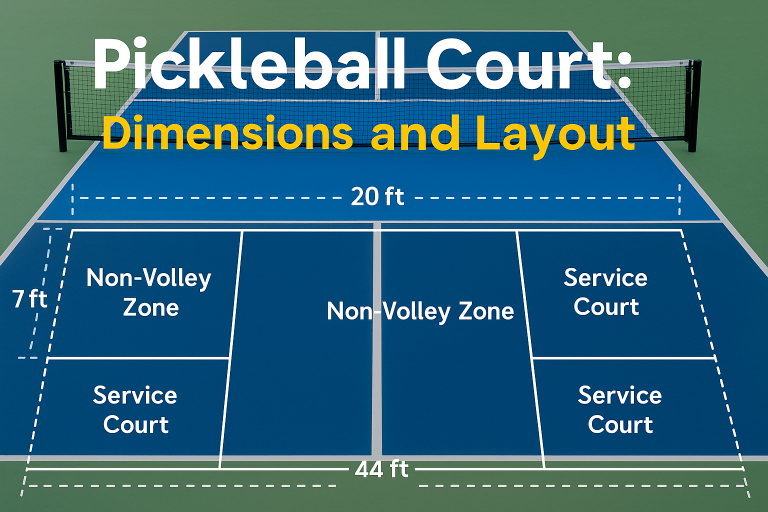Pickleball is one of the fastest-growing sports in North America and globally, blending elements of tennis, badminton, and ping-pong. Whether you’re a curious beginner, a homeowner looking to install your own court, or a community organizer hoping to promote healthy activities, understanding what a pickleball court is and how it functions is crucial. In this comprehensive guide, we’ll cover everything from court dimensions and surfaces to how to build one, play on it, and maintain it.
Read more- Badminton
What Is a Pickleball?
A pickleball is the designated playing area for the sport of pickleball. It resembles a smaller tennis court and can be used for both singles and doubles matches. The standard size of a pickleball court is 20 feet wide by 44 feet long for both singles and doubles. The net is 36 inches high at the sidelines and 34 inches at the center.
The court is divided into several areas:
- Baseline: The back boundary line.
- Sideline: The side boundary line.
- Non-volley zone (or “kitchen”): A 7-foot area on both sides of the net where volleying is prohibited.
- Service areas: Divided into left and right zones for serving purposes.
Dimensions and Layout
A pickleball court follows a specific layout and dimensions, making it easy to convert existing tennis or badminton courts into pickleball courts.
Key Dimensions:
- Court Size: 20′ x 44′
- Net Height: 34″ in the center, 36″ at the ends
- Non-volley Zone: 7′ from the net on both sides
- Service Boxes: Each side is divided into two 10’ x 15’ boxes
You can fit up to four pickleball courts on a standard tennis court, making multi-use sports facilities increasingly popular.
Types of Pickleball Courts
Pickleball courts come in various forms, depending on usage and installation:
- Indoor Courts: Usually found in gymnasiums with hardwood or rubberized flooring.
- Outdoor Courts: Often made with concrete or asphalt, topped with acrylic coatings to provide texture and color.
- Portable Courts: Temporary courts created with court tape or chalk, typically for events or in community centers.
- Dedicated Courts: Specifically constructed for pickleball, offering better play quality and durability.
How to Build a Pickleball Court
Building a pickleball court can range from a simple DIY project in your backyard to a professional-grade installation.
Steps to Build a Court:
- Site Selection: Choose a flat, open area.
- Surface Preparation: Level and clean the ground.
- Court Dimensions: Mark the court using measuring tools.
- Surface Coating: Apply non-slip paint or coating.
- Net Installation: Secure a regulation-size pickleball net.
- Fencing & Lighting (optional): Install for protection and nighttime play.
Estimated Cost:
Ranges from $5,000 to $30,000 depending on location, materials, and features.
Court Surface Materials
The quality of play is significantly influenced by the type of surface used.
Popular Materials:
- Concrete: Durable and low-maintenance.
- Asphalt: More affordable but less durable than concrete.
- Modular Tiles: Quick to install and easy on joints.
- Cushioned Surfaces: Ideal for players with joint concerns.
Each material has its pros and cons, so selection depends on your budget and playing preferences.
Pickleball Court Maintenance
Regular maintenance extends the life of your court and ensures safe play conditions.
Maintenance Tips:
- Clean debris regularly
- Check for cracks or surface damage
- Repaint faded lines
- Ensure the net is at the correct height
- Inspect for moss or algae in outdoor courts
Routine inspections are essential, especially for outdoor pickleball exposed to weather.
Rules and Etiquette on the Pickleball Court
Pickleball is not only about skill but also about maintaining good sportsmanship.
Basic Rules:
- Serve underhand and diagonally
- One bounce per side before volleys
- No volleying in the kitchen zone
- Only the serving team can score
Etiquette Tips:
- Wait your turn when courts are full
- Avoid disruptive behavior
- Respect line calls
- Congratulate opponents win or lose
Pickleball Court vs. Tennis Court
Many people wonder how a pickleball court compares to a tennis court. Here are the key differences:
| Feature | Pickleball Court | Tennis Court |
|---|---|---|
| Size | 20’ x 44’ | 36’ x 78’ |
| Net Height | 34″ (center) | 36″ (uniform) |
| Number of Players | 2 or 4 | 2 or 4 |
| Surface Needs | Lower impact | Higher impact |
| Noise Level | Moderate | Lower |
Thanks to its smaller size and lower impact, many players find pickleball court easier to learn and more accessible across age groups.
Benefits of Having Access to a Pickleball Court
Whether it’s in your backyard, community center, or gym, access to a pickleball court has many advantages:
- Promotes cardiovascular health
- Enhances hand-eye coordination
- Encourages social interaction
- Suitable for all age groups
- Low risk of injury
Conclusion: Why Every Community Needs a Pickleball Court
Pickleball is more than just a trend—it’s a movement. With its easy learning curve, small court size, and low-impact gameplay, it appeals to people of all ages and athletic abilities. Whether you’re playing for fun or investing in a court, understanding the layout, construction, and maintenance of a pickleball court can go a long way in promoting this inclusive sport.
Frequently Asked Questions (FAQs)
Q1: How much space do I need to build a pickleball court?
You need a minimum of 30′ x 60′ for a full court with safe surrounding space.
Q2: Can I convert my driveway into a pickleball court?
Yes, with temporary nets and court tape, many people create playable courts on their driveways.
Q3: How long does it take to build a pickleball court?
Depending on complexity, it can take anywhere from a weekend (DIY) to several weeks (professional build).
Also Read- ImportantCool LifestyleHacks

